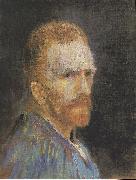
|
Godfried Schalcken
|
|||
|
|
|||
| Dutch 1643-1706 Godfried Schalcken was born in 1643 at Dordrecht, and he studied under Samuel van Hoogstraten in Dordrecht before he moved to Leiden, into the studio of Gerard Dou (1613-1675), one of Rembrandt's most famous pupils. His earlier genre pictures very closely resemble Dou's work. He worked in Leiden until c. 1675, then returning to Dordrecht until 1691, after which he settled in The Hague, where he continued to paint until his death, near age 63, in 1706. He also visited England (1692-1697), but his uncouth manners and bad temper alienated him from the society there. In 1703 he was employed by Johann Wilhelm, Elector Palatine in D??sseldorf. Mary Stanhope, Viscountess Fane, detail, 1702.Schalcken painted several portraits, of which the half-length of William III of England, now in the Rijksmuseum, Amsterdam, is a good example. Like Dou, Schalcken specialised in small scenes it by candlelight, a technique that found favour with the fijnschilders. Examples are in Buckingham Palace, the Louvre, Vienna and Dresden. His painting, Lady, Come into the Garden (Buckingham Palace), was singled out by his pupil Arnold Houbraken as representative of his oeuvre. Other good examples are Old Woman Scouring a Pan and Soldier Giving Money to a Woman (London, National Gallery), Ceres Seeking Proserpine and Old Man Writing (Louvre), Girl Blowing Out Taper (Munich), Girl Reading Letter (Dresden Gallery), The Boy Angling (Berlin); and Toilet by Candle (The Hague). The Buckingham Palace collection also possesses an interior by Schalcken. His history paintings are less-well known. | |||
|
|
|||
|
Selfportrait new24/Godfried Schalcken-437495.jpg Painting ID:: 74838 |
1679 Oil on canvas cjr | ||
|
|
|||
|
unknow artist
|
|||
|
|
|||
|
|
|||
|
Selfportrait new24/unknow artist-889977.jpg Painting ID:: 74999 |
c. 1843 Oil on canvas 61 x 50 cm cjr | ||
|
|
|||
|
Godfried Schalcken
|
|||
|
|
|||
| Dutch 1643-1706 Godfried Schalcken was born in 1643 at Dordrecht, and he studied under Samuel van Hoogstraten in Dordrecht before he moved to Leiden, into the studio of Gerard Dou (1613-1675), one of Rembrandt's most famous pupils. His earlier genre pictures very closely resemble Dou's work. He worked in Leiden until c. 1675, then returning to Dordrecht until 1691, after which he settled in The Hague, where he continued to paint until his death, near age 63, in 1706. He also visited England (1692-1697), but his uncouth manners and bad temper alienated him from the society there. In 1703 he was employed by Johann Wilhelm, Elector Palatine in D??sseldorf. Mary Stanhope, Viscountess Fane, detail, 1702.Schalcken painted several portraits, of which the half-length of William III of England, now in the Rijksmuseum, Amsterdam, is a good example. Like Dou, Schalcken specialised in small scenes it by candlelight, a technique that found favour with the fijnschilders. Examples are in Buckingham Palace, the Louvre, Vienna and Dresden. His painting, Lady, Come into the Garden (Buckingham Palace), was singled out by his pupil Arnold Houbraken as representative of his oeuvre. Other good examples are Old Woman Scouring a Pan and Soldier Giving Money to a Woman (London, National Gallery), Ceres Seeking Proserpine and Old Man Writing (Louvre), Girl Blowing Out Taper (Munich), Girl Reading Letter (Dresden Gallery), The Boy Angling (Berlin); and Toilet by Candle (The Hague). The Buckingham Palace collection also possesses an interior by Schalcken. His history paintings are less-well known. | |||
|
|
|||
|
Selfportrait new24/Godfried Schalcken-693437.jpg Painting ID:: 76301 |
Date 1679 Medium Oil on canvas cyf | ||
|
|
|||
|
unknow artist
|
|||
|
|
|||
|
|
|||
|
Selfportrait new24/unknow artist-954585.jpg Painting ID:: 76755 |
Date c. 1843 Medium Oil on canvas Dimensions 61 x 50 cm cyf | ||
|
|
|||
|
Vincent Van Gogh
|
|||
|
|
|||
| Dutch Post-Impressionist Painter, 1853-1890 Vincent Willem van Gogh (30 March 1853 ?C 29 July 1890) was a Dutch Post-Impressionist artist. Some of his paintings are now among the world's best known, most popular and expensive works of art. Van Gogh spent his early adult life working for a firm of art dealers. After a brief spell as a teacher, he became a missionary worker in a very poor mining region. He did not embark upon a career as an artist until 1880. Initially, Van Gogh worked only with sombre colours, until he encountered Impressionism and Neo-Impressionism in Paris. He incorporated their brighter colours and style of painting into a uniquely recognizable style, which was fully developed during the time he spent at Arles, France. He produced more than 2,000 works, including around 900 paintings and 1,100 drawings and sketches, during the last ten years of his life. Most of his best-known works were produced in the final two years of his life, during which time he cut off part of his left ear following a breakdown in his friendship with Paul Gauguin. After this he suffered recurrent bouts of mental illness, which led to his suicide. The central figure in Van Gogh's life was his brother Theo, who continually and selflessly provided financial support. Their lifelong friendship is documented in numerous letters they exchanged from August 1872 onwards. Van Gogh is a pioneer of what came to be known as Expressionism. He had an enormous influence on 20th century art, especially on the Fauves and German Expressionists. | |||
|
|
|||
|
Selfportrait new25/Vincent Van Gogh-547857.jpg Painting ID:: 84757 |
Date Paris, Summer 1887 Medium Oil on canvas Dimensions 41 x 33,5 cm cjr | ||
|
|
|||
|
Also Buy::. For Following Paintings / Artists / Products, Please Use Our Search Online: |












